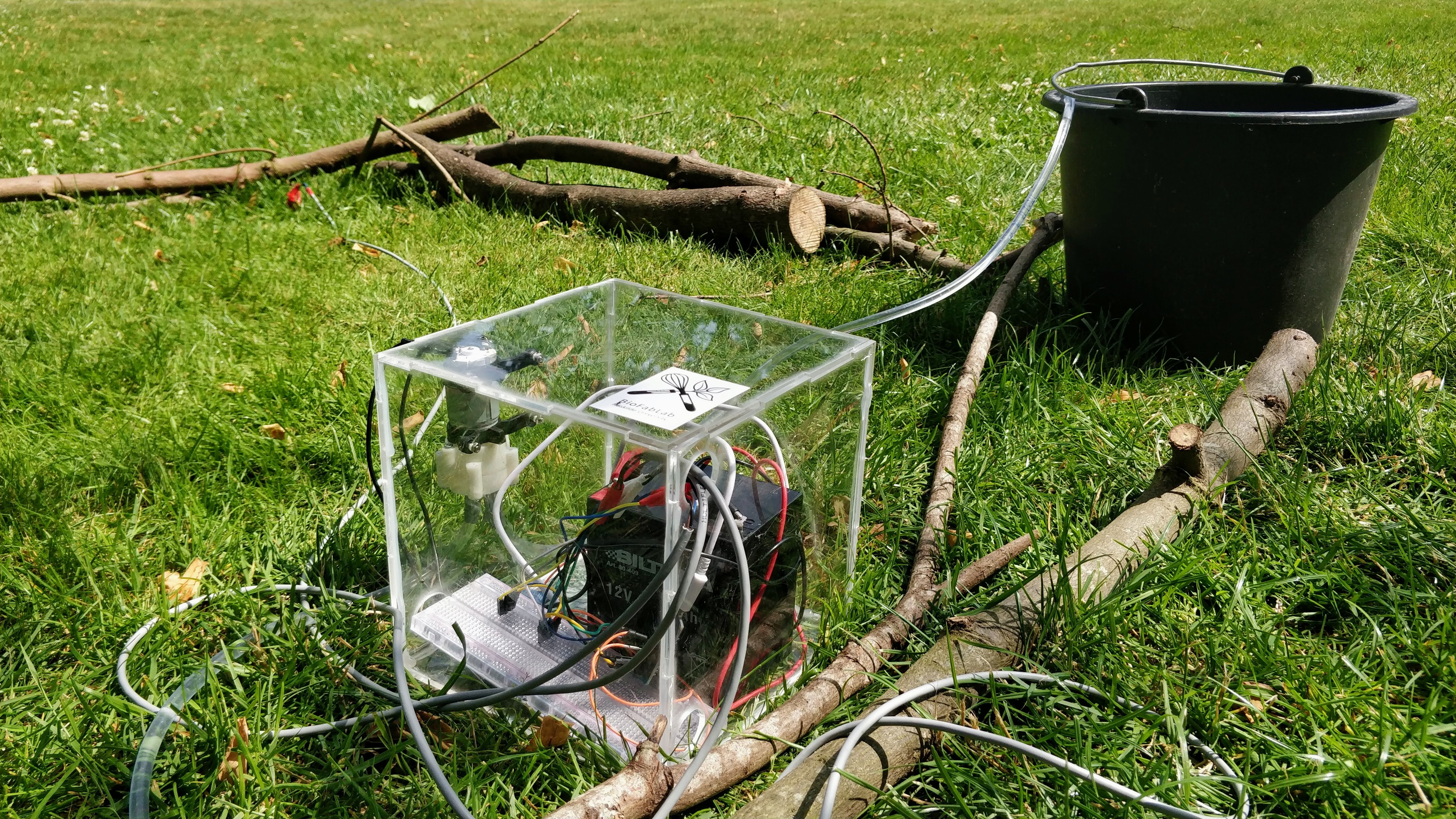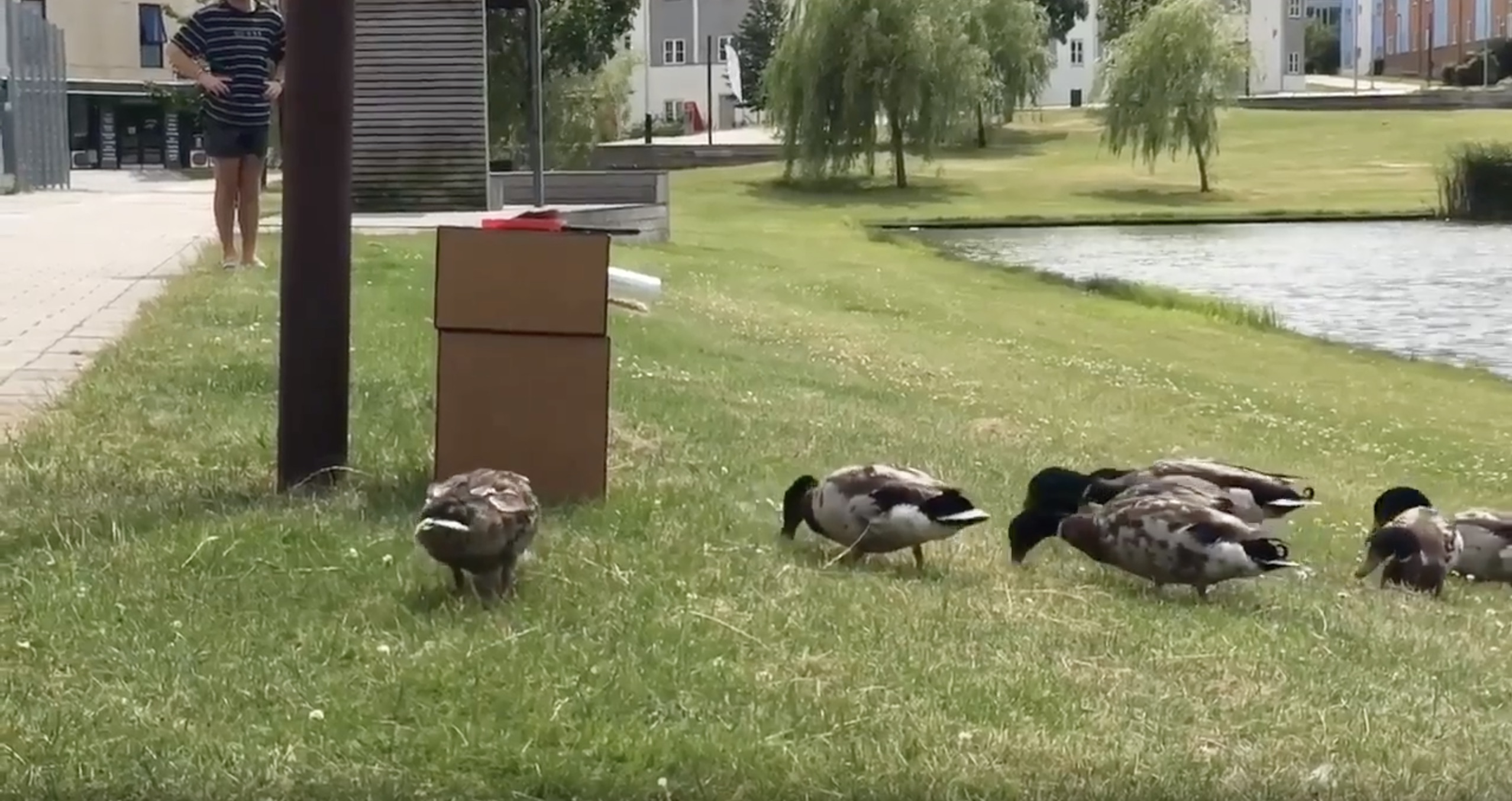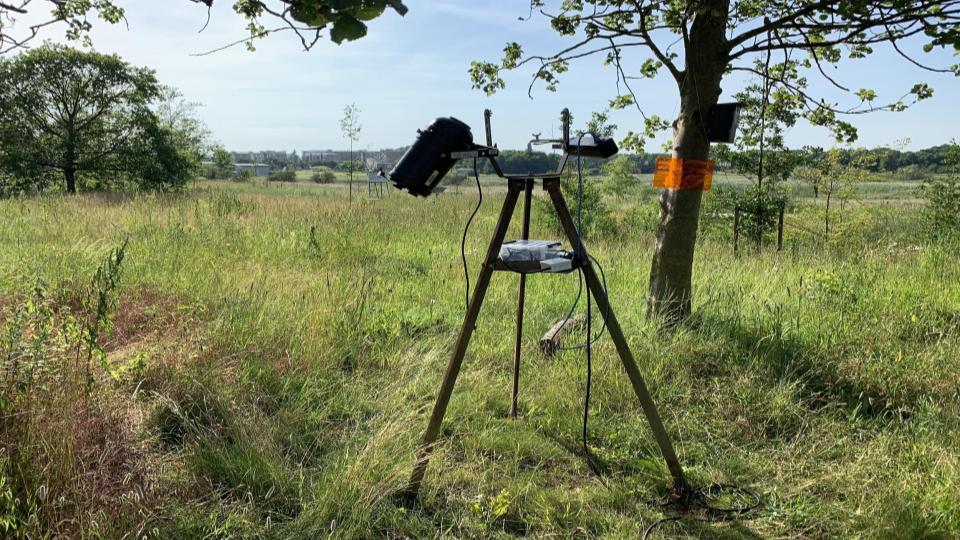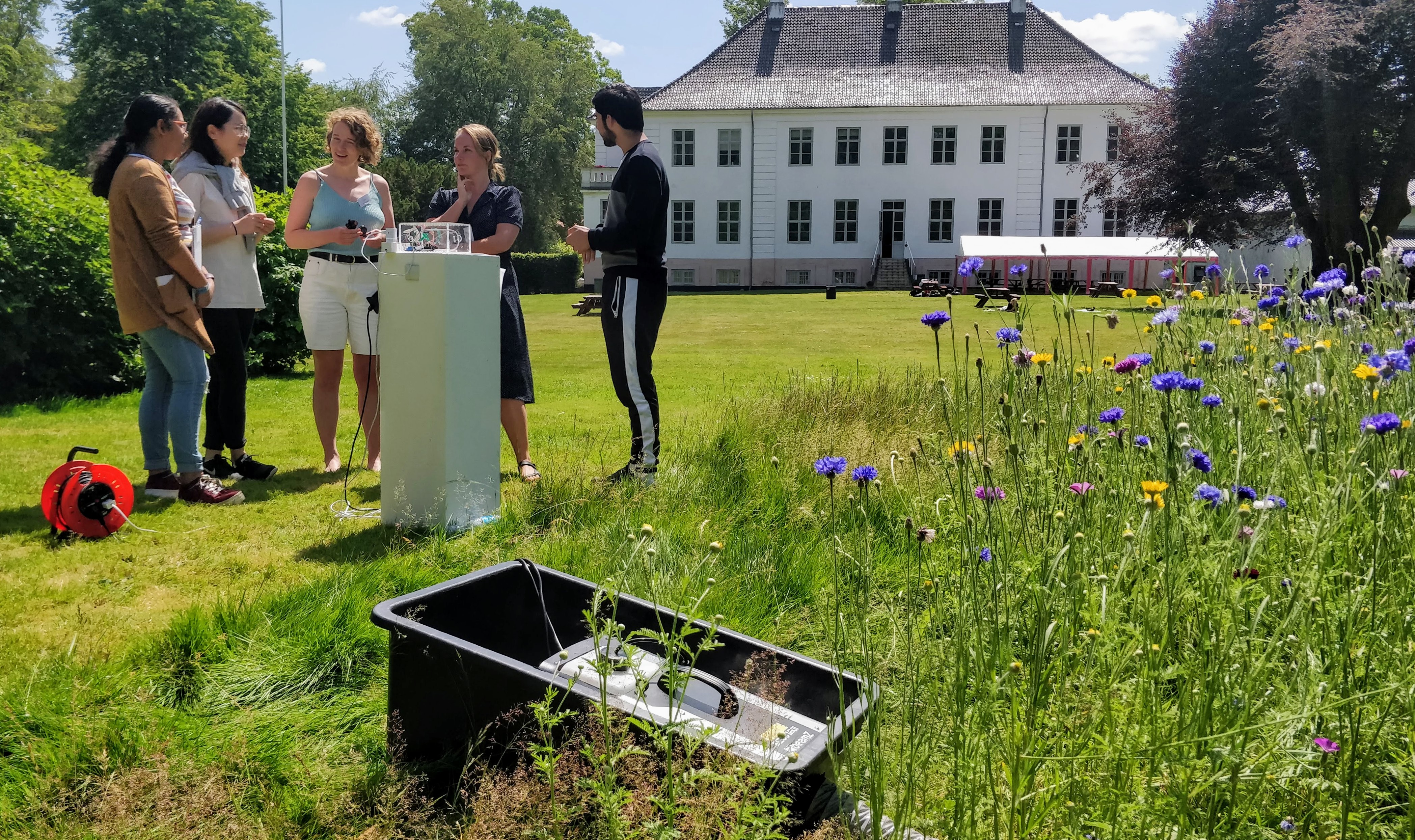"Do ducks need help?" Prototyping interactive installations for ducks and other non-human actors
by Martin Malthe Borch & Sara Daugbjerg
Documentation of a three week summer course on programming interactive installations for non-human actors. Here is a short presentation of the motivation behind the course, the outline, lectures, tools and final student projects. The participants where a culturally and educationally mixed group of international students.
Introduction
Biology as plants, bacteria, algae, insects and other non-human organisms have started to be used as tools or material for experimentation in many non-biological disciplines as design, architecture, programming, art and fashion. Living organisms, are also being introduced into makerspaces and fablabs. Several projects are emerging where the open source and easy accessible electronics and digital fabrication tools in these spaces, are being used in combination with plant cultivation, growth chambers, art, design and DIYbio experiments.
Complication
At FabLab RUC we are often approached by students or individuals from the general public that want to work within a biological or ecological domain. Often their initial idea can be summarised to something like this: “We want to design a technological sustainable solution that can improve biodiversity, minimise resource demand and lead us to green growth and a future in harmony with nature”. This often leads to conversations about what this actually means? What does “green” and “sustainable” mean? How they can we be sure that this actually do help "nature"? The many layers of meaning in these words blur the communication and prevent the conversation to get below the surface of superficial clichés and into the actual physical reality of the biological ecological system that we are all part of.
Motivation
We have for some time worked on a good frame on how to integrate biological prototyping into the fablab context. We see a tendency to approach the biological organisms as something that can be programmed or modelled to fit the desire of the designer or inventor. We see this trend as a rise in the amount of design and architectural schools that are adding more living biology into their curriculum and workshops.
Question
This have lead us to reflect on: “How can we design a course and facilitate design processes, that introduce the ecological and biological principles and functionality into projects that wants to be sustainable? And especially how do we approach this when what they are working on doesn't have anything to do with biology or ecology. How can we bring a biological or ecological design principles into the projects and the students minds, without first handing them several books about biology, ecology and ecosystem?
Hypothesis and Aim
We have worked on this in several workshops and courses. This summer we set up a course called biofabbing and ecology. The aim was for the students to learn to program interactive installations, but instead of focusing on interactive installations for humans we wanted the students to design interactive installations for non-human actors or an ecological system. We wanted to set up a frame and design process that went beyond an anthropocentric starting point, and the language and metaphors that comes with this.
The Hypothesis was that by introducing examples and languages, we could facilitate a more rich conversation and design process. We wanted to show reference projects and facilitate shared experiences such that everything together could establish a small reference frame and platform for a more non-human centric conversation. We wanted the other actors to be equal with the designers and the object being designed. So Beyond the aim of teaching students to code, the course also aimed at deconstructing the dualistic nature-culture divide, and introduce a new vocabulary that would enable the students to engage with an ecocentric design process.
The hope was that the projects and the final build installations carry ideas or memes that represents, and is derived from this ecocentric design perspective. We don't try to claim that this approach then will be more "sustainable" or better for the surrounding ecosystem. We are though curious about what this approach can contribute to a conversation about ecocentric and non-human centric design.
Approach & Method
We wanted to facilitate the students to engage in a open, curious and playful design approach with the biological material and the non-human actors, un constrained by existing narratives of how they should expect things to act, and free from how they are supposed to relate to these entities.
As the theme of the course potentially would encourage the students to relate to issues on climate change, ecosystems and their complex interrelation with design, social dynamics, politics industrial production and the dynamic nature of the non-human actors.
We as facilitators tried to make clear that we did not know what was right or wrong, and that we don't have answers to these types of wicked-problems. Instead we encouraged open ended playful exploration of the their ideas.
There are several theories and philosophies that talk about how you relate to, change or intervene in a very complex system that consists of both humans, electronics, code and non-human actors and organisms. Here we want to focus on the documentation, what we did and what the students god out of it. We are in a process of writing a text that explains some of our theoretical thoughts more in depth.
Course description
To build up a common reference frame and mindset we introduced the students to:
- A critique of, and alternative definitions to the words “green”, “sustainable” and “nature”.
- Ecopoetry,
- biomedia art, and
- biodesign projects.
- Folklore tales,
- Ecoempathy meditation and bodily exercises, and finally.
- Actor network theory.
We combined this with our well proven fablab practice, where we are teaching through rapid prototyping based on playful material exploration. We chose to enable the students to build, create and engage with simple electronics, maker-prototyping and programming first, and then introduce the critical reflections as questions were encountered through the designs they were making.

Student projects
All the project groups succeeded in building and programming a functional prototype of an ecocentric design installation. We present them below.
“Self” watering ecosystem
This project consisted of a fenced area and a moisture sensing watering system. It was designed to be installed at a festival setting. The group wanted to investigate if a design could be made, that would protect a small piece of grass from being trashed at a music festival. They build an installation that protected a small area, measured the humidity of the soil and watered it if needed, and communicated with the festival goers.

Interactive duck feeding system
The starting point for this project was feeding the ducks at the university lake and designing an interactive installation around this. The group went from designing a feeding machine for human entertainment as a first prototype to a duck-operated-feeding machine, that would release a small amount of food, based on motion sensing.

Insect Attraction
This project aimed to build an automated light installation, that attracted or repelled different insects to a small defined area, to support with pollination or add extra grow light for the plants. This installation was mainly designed for night use, where light has significantly more impact and insect become more visible.

Death free Insecticides
This group was interested in designing alternative insecticide methods . They experimented with using smoke, with the intention to repel or attract different insects to the different plants or crops.


Outcome
In general, we were very happy with the course and the final projects of the students. All of the groups succeeded in designing an installation and coding the electronics. Additionally there where a good level of reflection about the process and their design. Here the reflections of the duck feeding machine group, from a slide in their final presentation.
“The idea for the prototype resulted from a desire to interact with nature. The outcome represented a need for entertainment in order to contribute value to the environment. The original artificial aid we desired to create was overtaken by our need to feel absolved and gratified with our contribution. The design failed to reflect the needs of the very organisms it’s set to provide for. Do ducks need help? Do they need to be fed? Would human interaction do more harm than good? The design intended to help nature however we believe the idea truly reflected using our idea of what is good for us and for nature without considering whether or not our input is necessary or positive.”
Conclusions
The process and the final prototypes showed that:
A completely non-human design was impossible to design, and also a paradox in the real world context of the course. Evidently, the students could not make themself disappear when making and designing something. Humans are ubiquitous everywhere, and to create a sharp and meaningful design the students needed to include “humans” not least themselves and their own curiosity and playfulness into the design process.
It was clear that in an ecocentric design process, the designer needs to apply a conscious ecosystem mindset and carefully analyse the system, by mapping all elements and species that they work with, and their interaction.
We succeed in introducing examples, narratives and a vocabulary that enabled the students to reflect on, and have a critical conversations about, their work in relation to the other species and the greater ecosystem they were designing for. Both we as facilitators and the students where very happy about this.
Challenges
It’s a challenge to work with actual living biology or interact with real ecosystems, as the timeframe needed to see changes in these systems often goes far beyond the timescale of the course. We would like to see the design co-evolve with the organisms. This can potentially take several years if you want to see the evolutionary capabilities of the organisms truly fold out. The ducks and the festival goers could though provide a good an instant feedback during the tests, but plants and grass could not. Also it’s difficult to monitor what goes on during the night, when some animals or insects are most active.
For the staff at the fablab it was an experiment and a challenge to setup and run the course. During the planning we struggled with deciding the balance between the amount of eco-theory and practical programming exercises. But we are very happy with how it turned out.
Learning & Perspectives
We realised during this 3 weeks course that there is two directions that we can take moving this course forward. One is focusing on critical and speculative design and the other one focus on working more actively with biological and ecological matter and craftsmanship. Examples could be water, microbes, algae bacteria, water treatment and nutrients.
By focussing on the speculative and critical prototyping approach. We might get very strong concepts, ideas, playful and aesthetic prototypes, but it might be difficult to have living biology in the installation. Thus you need to get feedback from someone with biological or ecological knowledge, otherwise the projects might end up as non-sense. We believe that such a speculative approach, can generate valuable artefacts that makes us reflect and discuss the design itself and raise relevant questions although biological evidence is yet absence. This approach is seen in the good work being developed at many biodesign courses, challenges and artworks that emerge these days.
Another approach or focus is to pick a standard biological model organisms and develop a small experimental design tool for this organism. Then we can get the student going faster with a real living organism. This will focus more on the biological aspects and how difficult it actually is to keep something alive and happily growing. We are looking forward to develop both aspects of this course further, both the critical and speculative element of working with biology, and our own biological design tool platforms in the biofablab as well.
Recommendations
The development of the living biological design tools, would benefit from a creative biolab that can keep the organisms we are working with alive and a space where the biological installations can stand for a long time. It just takes time to allow the organisms-object interactions to evolve, so the actual functionality and development over time can be observed.
We would further like to open this type of workshops up to everybody interested in learning programming, electronics and prototyping with biological matter, both all students at RUC, but also external students and individuals. We believe that the skills that we teach can be useful across many different disciplines, and we would like to have a group of students from very different disciplines to improve the peer-learning and the perspectives of the discussions. We believe that online learning and courses will grow and take over the classical university big-room-lectures, while this type of hands-on interdisciplinary workshops still will be needed to practice using the skills that you have whether they are learned online, or at a normal lecture.
Overall the course have created a spark in our own academic curiosity, practice and reflections and motivated us to dive into this research in future courses, talks and workshops.
If you have ides comments or questions, don't hesitate to get in touch.

